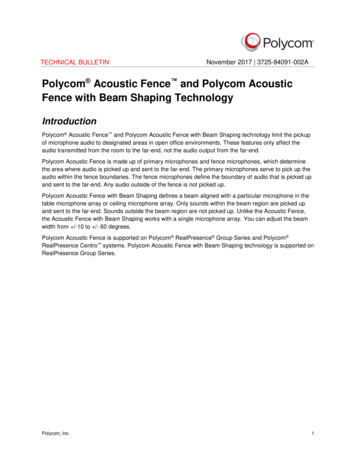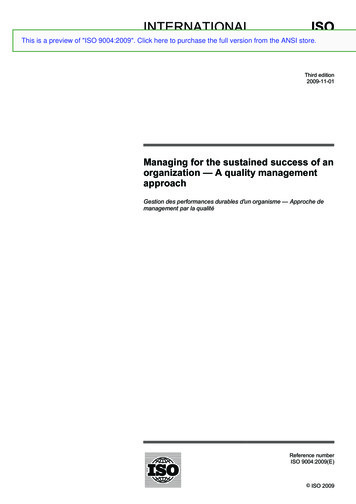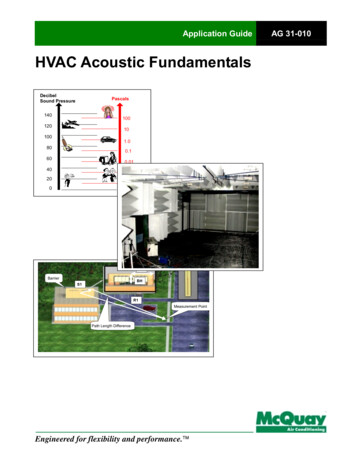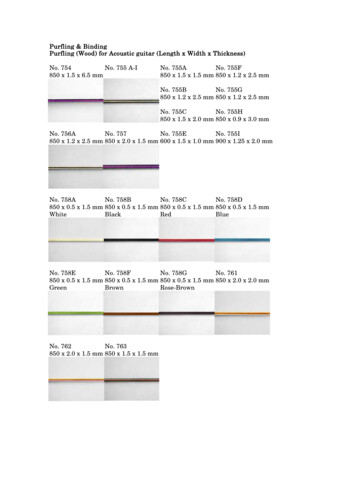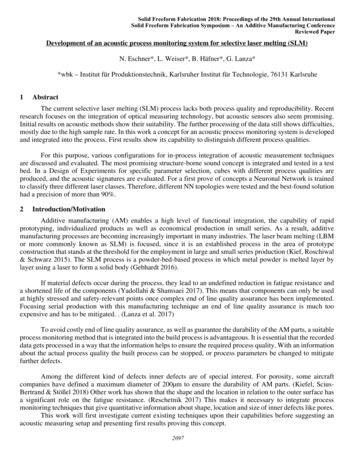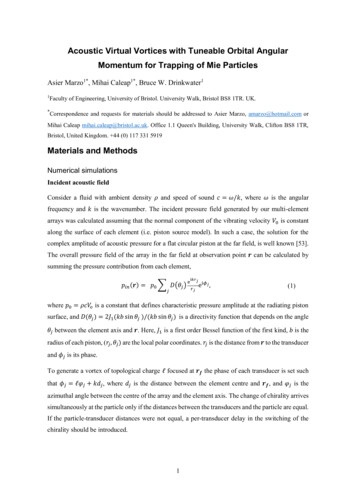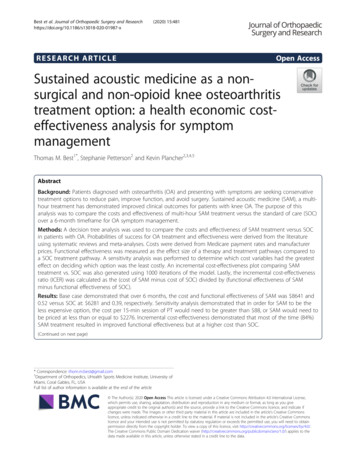
Transcription
Best et al. Journal of Orthopaedic Surgery and (2020) 15:481RESEARCH ARTICLEOpen AccessSustained acoustic medicine as a nonsurgical and non-opioid knee osteoarthritistreatment option: a health economic costeffectiveness analysis for symptommanagementThomas M. Best1*, Stephanie Petterson2 and Kevin Plancher2,3,4,5AbstractBackground: Patients diagnosed with osteoarthritis (OA) and presenting with symptoms are seeking conservativetreatment options to reduce pain, improve function, and avoid surgery. Sustained acoustic medicine (SAM), a multihour treatment has demonstrated improved clinical outcomes for patients with knee OA. The purpose of thisanalysis was to compare the costs and effectiveness of multi-hour SAM treatment versus the standard of care (SOC)over a 6-month timeframe for OA symptom management.Methods: A decision tree analysis was used to compare the costs and effectiveness of SAM treatment versus SOCin patients with OA. Probabilities of success for OA treatment and effectiveness were derived from the literatureusing systematic reviews and meta-analyses. Costs were derived from Medicare payment rates and manufacturerprices. Functional effectiveness was measured as the effect size of a therapy and treatment pathways compared toa SOC treatment pathway. A sensitivity analysis was performed to determine which cost variables had the greatesteffect on deciding which option was the least costly. An incremental cost-effectiveness plot comparing SAMtreatment vs. SOC was also generated using 1000 iterations of the model. Lastly, the incremental cost-effectivenessratio (ICER) was calculated as the (cost of SAM minus cost of SOC) divided by (functional effectiveness of SAMminus functional effectiveness of SOC).Results: Base case demonstrated that over 6 months, the cost and functional effectiveness of SAM was 8641 and0.52 versus SOC at: 6281 and 0.39, respectively. Sensitivity analysis demonstrated that in order for SAM to be theless expensive option, the cost per 15-min session of PT would need to be greater than 88, or SAM would need tobe priced at less than or equal to 2276. Incremental cost-effectiveness demonstrated that most of the time (84%)SAM treatment resulted in improved functional effectiveness but at a higher cost than SOC.(Continued on next page)* Correspondence: thom.m.best@gmail.com1Department of Orthopedics, UHealth Sports Medicine Institute, University ofMiami, Coral Gables, FL, USAFull list of author information is available at the end of the article The Author(s). 2020 Open Access This article is licensed under a Creative Commons Attribution 4.0 International License,which permits use, sharing, adaptation, distribution and reproduction in any medium or format, as long as you giveappropriate credit to the original author(s) and the source, provide a link to the Creative Commons licence, and indicate ifchanges were made. The images or other third party material in this article are included in the article's Creative Commonslicence, unless indicated otherwise in a credit line to the material. If material is not included in the article's Creative Commonslicence and your intended use is not permitted by statutory regulation or exceeds the permitted use, you will need to obtainpermission directly from the copyright holder. To view a copy of this licence, visit http://creativecommons.org/licenses/by/4.0/.The Creative Commons Public Domain Dedication waiver ) applies to thedata made available in this article, unless otherwise stated in a credit line to the data.
Best et al. Journal of Orthopaedic Surgery and Research(2020) 15:481Page 2 of 10(Continued from previous page)Conclusion: In patients with osteoarthritis, SAM treatment demonstrated improved pain and functional gainscompared to SOC but at an increased cost. Based on the SAM treatment ICER score being 50,000, it appearsthat SAM is a cost-effective treatment for knee OA.Keywords: Osteoarthritis, Sustained Acoustic Medicine, Physical therapy, Socio-economical impact, Cost-effectanalysis, Health care costIntroductionOsteoarthritis (OA) is the most common type of arthritis affecting over 63 million adults in the USA annually [1]. The most common presentation of OA isin the knee, occurring in 10–13% of men and womenover the age of 60 with an estimated 14 millionpeople having this condition [2, 3]. The prevalence ofOA is projected to increase as people become moreobese and the population skews towards older age.OA is characterized by joint inflammation withchronic pain and decreased function of the joint asstiffness and swelling limit mobility.4 In turn, qualityof life and productivity are adversely affected [3, 4].Pain from OA is one of the key reasons why patientsseek medical care and generally precedes disability/lossof function [5]. As the pain worsens, the treatments firstfocus on pain relief and the inflammatory aspects of thedisease [6]. In recent years, there has been an increasingemphasis on non-pharmacologic therapies to treat thesymptoms of OA including physical therapy, exercise,massage, and ultrasound which for most are not as easilyaccessed due to patients lacking the resources or abilityto do so, ultimately contributing to worse pain andgreater disability [7]. Recent recommendations by theAmerican College Rheumatology (ACR)/Arthritis Foundation for treating knee OA call for a comprehensiveplan including the above therapies which may be used insequence, again depending upon pain severity [8].The effectiveness of ultrasound as a therapy for OArelated pain and disability has been substantiated in anumber of systematic reviews and meta-analyses [9–12].However, one of the challenges with current ultrasounddelivery is that reimbursement requires administrationvia constant attendance by a care provider in a professional setting, generally for a short duration of time (5–10 min) over approximately a 30-day period. This islikely due to the types of high quality studies that haveexamined this condition and associated treatment protocols as well as payer policies, which only cover for directone-on-one constant attendance by a provider [13–15].The policies and in-office treatment requirement prohibits daily treatment in the clinical setting for many patients and medical professionals. Despite the shortduration of in-clinic ultrasound treatment, residual positive effects on pain and function with this modalityappear to last upwards of 1 year [16, 17]. Recently, daily,multi-hour sustained acoustic medicine (SAM), lowintensity, long-duration wearable ultrasound has beenfound to provide effective pain relief and functional improvement in patients with knee OA [18–23].It is with the above in mind that a cost-effectivenessanalysis was undertaken to examine accepted treatmentpathways in using SAM ultrasound versus standard ofcare (SOC) in the relief of knee OA pain and improvement of function over a 6-month period. The reason 6months was chosen is that all generally accepted therapies for pain relief could be evaluated, with the intentionthat therapies that improve function could then be evaluated. The purpose was to examine the overall directcosts for care in using one therapy versus another and toexamine the outcome of the patient. Additionally, theSAM ultrasound therapy system that can be used in thehome over long durations without direct one-on-oneprovider contact was evaluated. To our knowledge, suchan analysis has not been previously conducted.MethodsThe patients evaluated in the model presented withpain characterized as intense, unpredictable, and emotionally draining resulting in the avoidance of physicalactivity [24]. In other words, the pain was severeenough such that there was an avoidance of physicaltherapy, which has consistently been shown to improve function [25]. This type of pain is also distressing enough that it affects the person’s quality of life,limiting activities of daily living and other recreationalactivities [16]. Additionally, these patients were 65years of age (i.e., non-Medicare).The clinical guidelines used for treatment of knee OAin this assessment were the 2019 ACR/Arthritis Foundation guidelines for the management of OA of the hand,hip, and knee [8]. All therapies recommended by theACR were used in the model. However, one therapy thatwas not recommended by the ACR was also used, hyaluronic acid (HA) injections (ACR has a conditionallyrecommended against for HA) [8]. Inclusion of HA usewas due to the identification of a 2009 Cochrane Reviewon viscosupplementation where HA was supportive ofits use for relieving pain [25].
Best et al. Journal of Orthopaedic Surgery and Research(2020) 15:481Identification of the highest quality of evidence wasused in the evaluation of outcomes for pain relief andfunction for all therapies. The types of studies identifiedtherefore were systematic reviews and meta-analyses.PubMed and Cochrane Library were the databasessearched with the key words used for identifying studiesbeing:((((((((((((((systematic) AND review) AND metaanalysis) AND pain) AND knee) AND osteoarthritis)AND outcome)) AND function)) AND random*) ANDcontrol*) AND trial)) AND NSAID–hits 292((((((((((((((((systematic) AND review) AND metaanalysis) AND pain) AND knee) AND osteoarthritis)AND outcome)) AND function)) AND random*) ANDcontrol*) AND trial)))) AND physical therapy–hits 1,174.((((((((((((((((((systematic) AND review) AND metaanalysis) AND pain) AND knee) AND osteoarthritis)AND outcome)) AND function)) AND random*) ANDcontrol*) AND trial)))))) AND hyaluronic acid–hits 186(((((((((((((((((((((((systematic) AND review) ANDmeta-analysis) AND pain) AND knee) AND osteoarthritis) AND outcome)) AND function)) AND random*)Page 3 of 10AND control*) AND trial)))))))))) AND steroid) AND injection*–hits 211((((((((((((((((((((systematic) AND review) AND metaanalysis) AND pain) AND knee) AND osteoarthritis)AND outcome)) AND function)) AND random*) ANDcontrol*) AND trial)))))))) AND ultrasound – hits 453.Figure 1 identifies the process of identifying the systematicreview and meta-analyses used in the current analysis.In order to simplify the model and not introduce confounding therapies, the assumption was made that therapies were used sequentially for both SAM treatmentand SOC based on ACR care guidelines. In other words,if a therapy improved upon pain enough (with pain being the limiting factor for engaging in PT) such that PTcould be initiated, it ended the decision to use anotherpain therapy. However, if pain was not improved, another modality was employed. The probability of improvement in pain such that PT could be initiated wasidentified in the systematic reviews and meta-analysesidentified in the searches [25–28].Costs were derived from manufacturer pricing [29], reimbursement rates over last 3 years for the SAM deviceFig. 1 PRISMA flow diagram for identification, screening, eligibility, and included articles in health economic modeling data
Best et al. Journal of Orthopaedic Surgery and Research(2020) 15:481including federal agencies TRICARE Military and VAHealth System [30], and from 2020 National Medicarerates adjusted by the ratio of Medicare payments tocommercial payments in order to obtain the commercialrates [31, 32].Lastly, the statistically significant effect sizes for a therapy in improving pain relief and function were identifiedin the systematic reviews and meta-analyses [27, 33, 34].The effect size is a simple way of quantifying the size ofa difference between 2 groups. An effect size of greaterthan 0.5 generally means that the difference is importantand can be observable which was used in the model[35]. It was further assumed that when PT was initiated(based on pain improvement), it was continued for theduration of the 6-month analysis as PT has been shownto have a positive effect on function over time [36]. Thenumber of sessions and duration (e.g. dosing) was derived from the medical literature whereby the largest effect could be identified [36].Pain and function were established endpoints of themodel as they are arguably of the most important outcomes in patients with knee OA. The American Academy of Orthopedic Surgeons (AAOS) has stated that:“the quality and success of interventions to treat OAshould be assessed based on outcomes deemed to be ofimportance to the patient. ”[37]. The measure of painand function in knee OA has also been established aspart of the physician quality reporting system (PQRS#109) [38].The incremental cost-effectiveness ratio (ICER) wasused in measure improvement of pain and function, andhas been used in the past in knee OA for determiningthe ICER of a therapy [39]. Pain and function have beenrecognized as important outcome measures by the Institute of Clinical Economic Review, a leading organizationin the area of value analysis of therapies [40]. For thisparticular analysis, the ICER was calculated as follows:(cost of SAM treatment minus cost of SOC)/(functionaleffectiveness of SAM minus functional effectiveness ofSOC).Tree Age Pro Healthcare 2020 software (TreeAge Software Inc., Williamstown, MA, USA) was used in theanalysis. The variables, distributions and equations usedin the model are found in Appendix 1 and 2. The decision tree is found in Fig. 2. Additionally, a tornado plotwas employed to determine which variables in the modelhad the greatest effect on costs such that one therapywas found to be less expensive than the other. Thesevariables were then examined individually in sensitivityanalysis to identify the value at which one therapy became more expensive relative to the other and whetherthis value was realistic in everyday practice. An ICERscatterplot was also evaluated whereby the variables inthe model were randomly varied 1000 times using thePage 4 of 10low and high values as identified in the variables/distributions (Appendix 1).Lastly included in the model, and as mentioned above,a wearable, long duration, continuous home-use ultrasound system that is self-administered, and capable ofdelivering 18,720 J of ultrasound therapy for up to 4 h/day generating vigorous deep musculoskeletal diathermyΔ8 C at 1 cm, Δ6 C at 3 cm, Δ3 C at 5 cm; and allowsa patient to utilize ultrasound therapy outside of a medical facility (Sustained Acoustic Medicine [SAM] device,FDA Approval # K191568, ZetrOZ Systems, LLC, Trumbull, CT, USA). This device has been used safely and effectively in the treatment of knee OA [20–23] chronicmyofascial pain [41–43], tendinopathies [44–47], and forhealing various musculoskeletal injuries [19, 22, 44–47].Markov modeling (1000 iterations) was used to examineon a percentage basis were SAM treatment would be amore effective and more costly therapy versus SOC.ResultsIn the initial knee OA care pathway of the model shownin Fig. 2, the cost and effect size on pain and functionover 6 months was 8641 and 0.52, respectively for SAMtreatment and 6282 and 0.39, respectively for SOC.Thus, the ICER for the use of SAM was 18,146 ( 8641less 6282)/(0.53 less 0.39). In the later stage, knee OAcare pathway with response to SAM with the addition ofPT the cost and effect size was 13,967 and 0.77, respectively, versus SOC combined with NSAIDs and PTat 9294 and 0.47, respectively. The later care pathwaySAM ICER value was 15,576 ( 13,967 less 9,294)/(0.77less 0.47).A tornado plot (Fig. 3) identified the following variables which had the greatest effect on cost (i.e., in identifying SAM as the least costly option) including the costof SAM, cost of a 15-min PT session, and the number ofPT sessions. Additional sensitivity analysis identified thefollowing variables and their threshold values were SAMtreatment becomes the less costly alternative (Table 1).In order for SAM treatment to be the less expensiveoption relative to SOC, it would need to cost 2276(Fig. 4). The price of SAM treatment used in the model is 4635 (average reimbursement price of the unit). ForSAM treatment to be the less expensive option, the costof PT would need to be 88 per 15-min session (Fig. 5).It is assumed in the model that the cost per 15-min PTsession was 41.80 and that a patient would receive anywhere from 2 to 4, 15-min sessions per visit. Or in orderfor SAM treatment to be the less expensive option, 144total sessions (15-min per session) would need to occur(Fig. 6). Lastly, Fig. 7 demonstrates in Markov modelingthat 84% of the time SAM treatment was more effective inpain and function outcomes for knee OA versus SOCpathway, and a more costly therapy versus SOC over 6
Best et al. Journal of Orthopaedic Surgery and Research(2020) 15:481Page 5 of 10Fig. 2 Decision tree model of cost, effect size, and probability for the 6-month management of knee osteoarthritis. Physical therapy combinedwith SAM provides superior non-invasive and drug-free treatment versus the SOC care pathway for patientsFig. 3 Model variables with greatest effect on cost of care pathway and the ranging parameters
Best et al. Journal of Orthopaedic Surgery and Research(2020) 15:481Page 6 of 10Table 1 Cost-effectiveness model variables where SAM treatment of knee osteoarthritis becomes less costly. Each model variable isindependent based on the base model assumptionsVariableValue at which SAM treatment becomes the less costly alternativeFigureSAM treatment cost 2276Fig. 4Cost for PT per session 88Fig. 5Number of 15 min PT sessions 144Fig. 6months of treatment. The centroided of the Markovmodel demonstrates an incremental cost of 2400 andeffect of 0.12 for SAM treatment of knee OA.DiscussionThe major finding from our analysis was that the home-useSAM device for the treatment of OA pain and subsequentimprovement in function and quality of life was costeffective with an ICER between 15,576 and 18,146. Thecalculated SAM ICER value range falls within acceptedcost-effectiveness threshold values in determining whethera therapy is cost-effective. The Institute for Clinical andEconomic Review considers ICERs of 50,000– 100,000high value care [40]. Payer organizations such Premera BlueCross of Washington identify therapies as cost-effective ifthey are between the values of 10,000– 50,000 [48]. Specialty societies such as the American College Cardiologyidentify high value care as an ICER 50,000 [48]. Lastly,cost-effectiveness systematic reviews for the surgical management of OA including procedures covered by Medicarehave ICER values 10,000– 100,000 [49].Reduction of pain and increased function are important outcomes for patients with knee OA and are commonly used as endpoints in studies examining therapiesfor treating this disease [49]. These endpoints are observable, measurable, and most relevant to the patient[37]. It has also been identified that function is highlycorrelated with quality of life (QoL) in patients withknee OA [50–52], another endpoint evaluated in ourICER analyses. Thus, the use of function as well as painas an outcome in ICER appears to be a good proxy forQoL and are commonly used [53].Widespread use of traditional ultrasound in treatingboth pain and improving function of patients is hampered by the requirement that it has traditionally beenlimited to us in a clinical setting, is of short duration,and must be applied by a clinician with direct providerto patient contact [13–15] These limitations are furtherenhanced by the recent 2020 pandemic which has reduced patient access to clinical practices and has resulted in new remote care policies being issued byinsurance carriers and governmental agencies [54, 55].Other limitations include specialty societies and payersin making recommendations for ultrasound treatment ofknee OA or lack thereof [8, 56–58]. Unfortunately, somepayer coverage and utilization policies have not been updated for over 10 years, failing to account for recent,high quality evidence in establishing coverage determinations [13, 14, 58]. Additionally, t
1Department of Orthopedics, UHealth Sports Medicine Institute, University of Miami, Coral Gables, FL, USA Full list of
